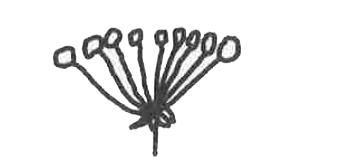Three types of flowers occur in the inflorescence of
Capitulum
Hypanthodium
Cyanthium
Umbel
The correct Answer is:B
To solve the question regarding the types of flowers that occur in the inflorescence, we will analyze the options provided and identify which inflorescence contains all three types of flowers: male, female, and sterile.
1. Understand the Question: The question asks which type of inflorescence has three types of flowers: male, female, and sterile.
2. Analyze the Options:
- Capitulum: This type of inflorescence usually consists of many small flowers (florets) that can be either all male or all female, but typically does not have all three types of flowers present.
- Hypanthodium: This inflorescence is characterized by a pear-shaped structure that has a cavity. In this cavity, female flowers develop at the base, while male flowers develop towards the opening (pore). This inflorescence can also contain sterile flowers, thus having all three types of flowers.
- Cyanthium: This type of inflorescence is typical of plants like Euphorbia, where the flowers are grouped in a way that does not typically include all three types (male, female, and sterile).
- Umbil: This is not a commonly recognized term in the context of inflorescence types and does not typically refer to a specific type of flower arrangement.
3. Identify the Correct Answer: Based on the analysis, the Hypanthodium inflorescence is the only one that contains all three types of flowers: male, female, and sterile.
4. Final Conclusion: The correct answer to the question is Hypanthodium.
- Capitulum: This type of inflorescence usually consists of many small flowers (florets) that can be either all male or all female, but typically does not have all three types of flowers present.
- Hypanthodium: This inflorescence is characterized by a pear-shaped structure that has a cavity. In this cavity, female flowers develop at the base, while male flowers develop towards the opening (pore). This inflorescence can also contain sterile flowers, thus having all three types of flowers.
- Cyanthium: This type of inflorescence is typical of plants like Euphorbia, where the flowers are grouped in a way that does not typically include all three types (male, female, and sterile).
- Umbil: This is not a commonly recognized term in the context of inflorescence types and does not typically refer to a specific type of flower arrangement.
Topper's Solved these Questions
- MORPHOLOGY OF FLOWERING PLANTS BOOK - CENGAGE BIOLOGY ENGLISHCHAPTER - MORPHOLOGY OF FLOWERING PLANTS EXERCISE - Assertion and Reason
11 Videos
- MORPHOLOGY OF FLOWERING PLANTS BOOK - CENGAGE BIOLOGY ENGLISHCHAPTER - MORPHOLOGY OF FLOWERING PLANTS EXERCISE - Archives
41 Videos
- MINERAL NUTRITIONBOOK - CENGAGE BIOLOGY ENGLISHCHAPTER - MINERAL NUTRITIONEXERCISE - ARCHIVES
39 Videos
- NEET 2017 PAPERBOOK - CENGAGE BIOLOGY ENGLISHCHAPTER - NEET 2017 PAPEREXERCISE - MCQ
45 Videos
Similar Questions
Number of flowers in the inflorescence of jasmine
View SolutionOpening of flowers in the inflorescence of carrot
View SolutionAssertion : In synconous type of fruit, the achenses formed are fewer than the total number of flowers in the inflorescence from which it is formed.
Reason : Upper and middle flowers cannot develop into fruits.
View SolutionOpening of flowers in the given inflorescence is

View SolutionTrimerous flowers occur in
View SolutionThere are 25 flowers in an inflorescence of Allium. Each anther lobe of every stamen contains 60 pollen grains. What is the total numbner of pollen grains produced in its inflorescence
View SolutionEpigynous flowers occur is
View Solutionthe type of inflorescence in hamelia is
View Solutionumbel inflorescence occurs in
View SolutionAchlamydeous flower occurs in
View Solution
